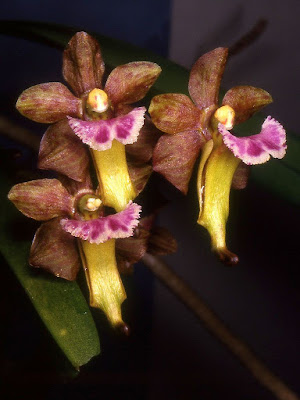The Fan-Shaped Aerides is native to Thailand, Myanmar and Yunnan China at forests edges or sparse woods, at elevations of 300 to 1700 meters. The plant is a small to just medium sized, hot to cool growing epiphytic species. Plants will eventually mature to 24" - 48" tall and 12" - 20" wide with the stems of 10-30 cm, stout. Leaf blade narrowly oblong or lorate, 16 × 1.5-2 cm, thickly leathery, conduplicate toward base, apex unequally bilobed or praemorse.
Aerides flabellata orchid, also called as The Fan-Shaped Aerides, is a species of the genus Aerides. This species was first described by Rolfe ex Downey in 1925. Another synonyms are know for this species such as: "Vanda flabellata (Rolfe ex Downie) Christenson 1985".
IDENTIFY AERIDES FLABELLATA OCHID
The Fan-Shaped Aerides is native to Thailand, Myanmar and Yunnan China at forests edges or sparse woods, at elevations of 300 to 1700 meters.
The plant is a small to just medium sized, hot to cool growing epiphytic species. Plants will eventually mature to 24" - 48" tall and 12" - 20" wide with the stems of 10-30 cm, stout. Leaf blade narrowly oblong or lorate, 16 × 1.5-2 cm, thickly leathery, conduplicate toward base, apex unequally bilobed or praemorse.
Plants will produce 1-3 inflorescences at a time. Each inflorescence will produce 5-10 flowers. The flower is fragrant and occurring in the spring. Individual flowers are 3/4" - 1 1/4" wide. Sepals and petals are yellow to yellow-green variously spotted and overlaid chestnut to mahogany. The lip is triple, is under the column, in its shape resembles a fan. The main color of the lip is white with purple spots. The middle part of the lip is curved back, and the lateral parts upward, along the lip, slightly indented and wavy. The spur is a little upward.
GROW AND CARE AERIDES FLABELLATA OCHID
Temperature:
This type of orchid refers to a warm temperature regime: in Summer 20-32 ° C; in Winter not below than 15 ° C. To successfully grow Aerides flabellata at home, it is necessary that the night temperature is always 4 ° C lower than the daytime temperature. For example, if the day is 30 ° C, then at night no more than 26 ° C.
Humidity:
The humidity required for this species is not exacting. For normal growth and development, the plant will be 50-70% sufficient. In winter, it is desirable to ensure the highest (of possible) indicators. To increase the humidity of the air, you can use an air humidifier, saucers with water or wet claydite. To do this, take a large pallet, inside which is filled with expanded clay, the top is laid protecting the waterlogging of the roots of the grate and exhibited pots with orchids.
Light:
This kind of orchids loves bright sunlight and is able to tolerate the direct morning and evening sun, but in the hot summer noon (especially in the windows of the southern orientation), the orchid should be protected from direct sunlight: put behind a curtain or into the shade of other plants. Otherwise, the plant may get sunburn.
Substrate and growing medium:
Plants are best grown hanged in baskets and on mounted. Plants should be grown in media that is well drained such as tree fern fibers (for small plants), several pieces of coarse fir bark, or sphagnum moss.
Watering:
During the whole year, Aerides flabellata needs frequent and abundant watering. To water this kind of orchids is best with the help of a hot shower. It mimics the natural conditions in the home of the orchid and has a beneficial effect on the growth and development of the plant. The water temperature should be 30-45 ° C. The substrate between watering should dry well.
In the hot summer period, daily spraying of the outer part of the plant is recommended, this will increase the humidity around the orchid and help it to survive the heat better.
Fertilizer:
Throughout the year, this type of orchid is fertilized for every third watering in the usual fertilizer concentration indicated on the package. Fertilizer should be used specialized with a mark on the package "For Orchids", since conventional fertilizers for houseplants contain a somewhat different composition of nutrients and their dosage is much higher than that required by Aerides flabellata.
Rest period and repotting:
Aerides flabellata does not need rest period. However, if you have problems with the flowering of this type of orchids, then try to keep the plant somewhat drier in winter than usual, and not to fertilize.
After flowering, the flower spike of Aerides flabellata is removed, if necessary, the orchid is repotting and kept dry for some time. This is necessary to acclimatize the plant and to prevent rotting of the roots from the repot.















COMMENTS